Abstract
1. The interactions between angiotensin II (AII), two non-peptide antagonists DuP 753 and IMI, and eight peptide analogues of AII were investigated on the rabbit isolated aorta assay. DuP 753 and IMI behaved as simple competitive antagonists (pKB values 8.4 and 6.8, respectively). To different degrees, all the AII-peptide analogue interactions failed to meet the basic criteria for simple competition. In addition to rightward shift, the most significant feature was a concentration-dependent saturable depression of the upper asymptote of the AII concentration-effect curves. 2. 'Washout' and combined dose-ratio analysis experiments, in which DuP 753 was used as a reference antagonist, indicated that the profile of peptide antagonism was solely due to a reversible and syntopic action at the AII receptor. 3. By use of an operational model of agonism (Black & Leff, 1983) as a starting point, it was possible to account for the data with a new model which describes reversible receptor occupancy and occupied receptor-determined, saturable reduction in the efficacy of AII. Model-fitting gave estimates of pKB values for the peptide analogues and agonist affinity and efficacy parameters for AII. 4. The model was successfully tested by applying it to qualitatively similar results obtained in a cross-tissue analysis on guinea-pig aorta, ileum and stomach. 5. A 'molecular' interpretation of the efficacy changes, based on the concepts of receptor internalisation and expression, is offered.
Full text
PDF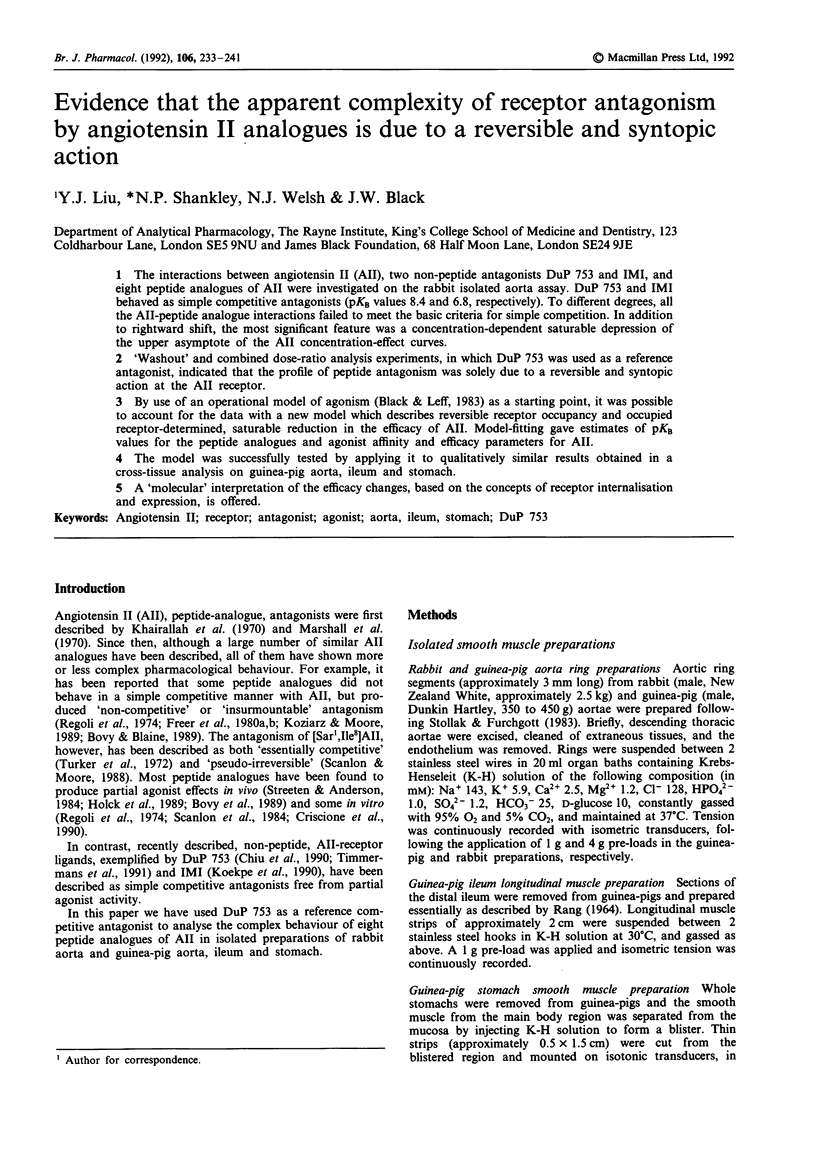
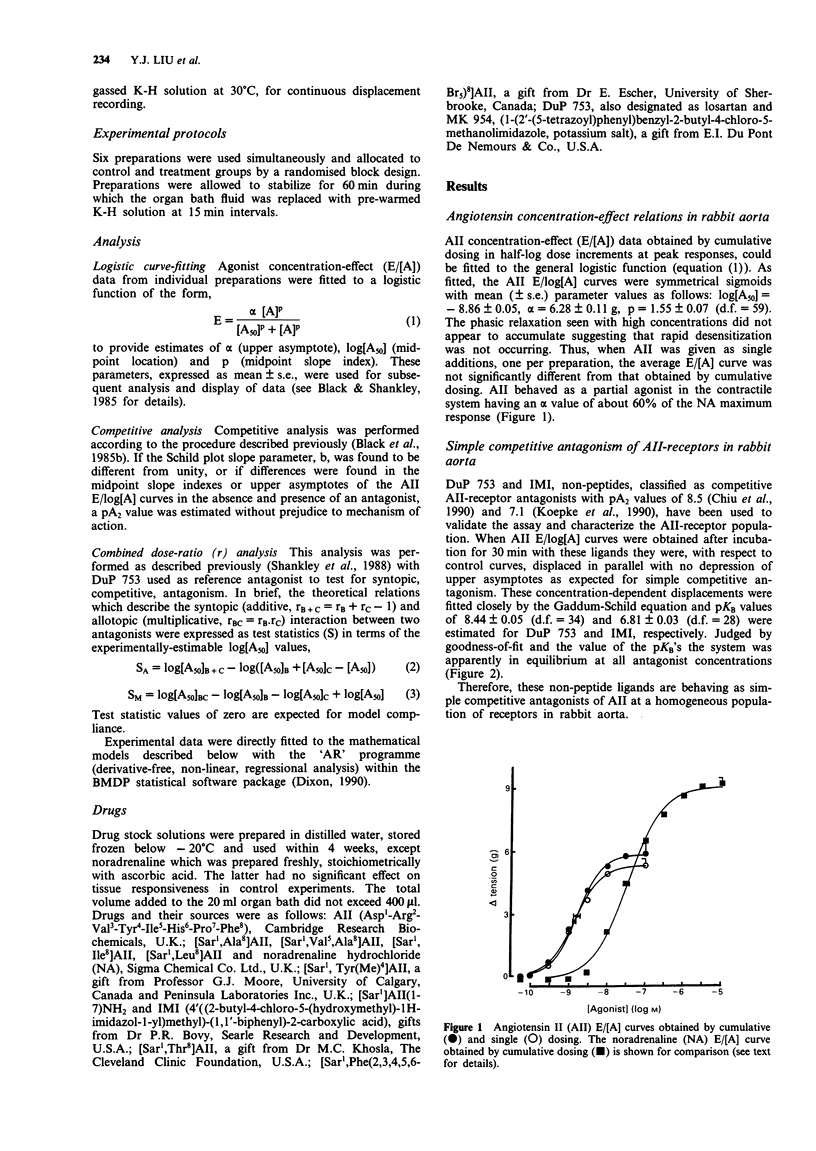
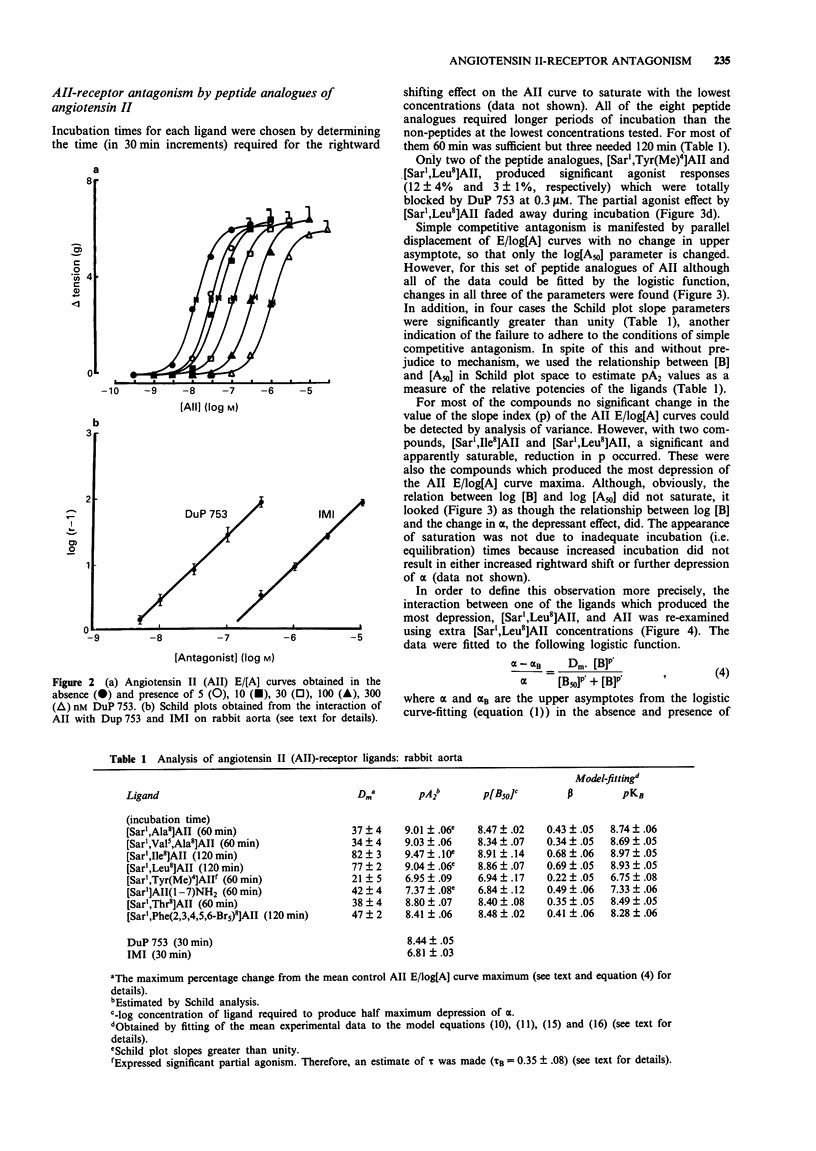
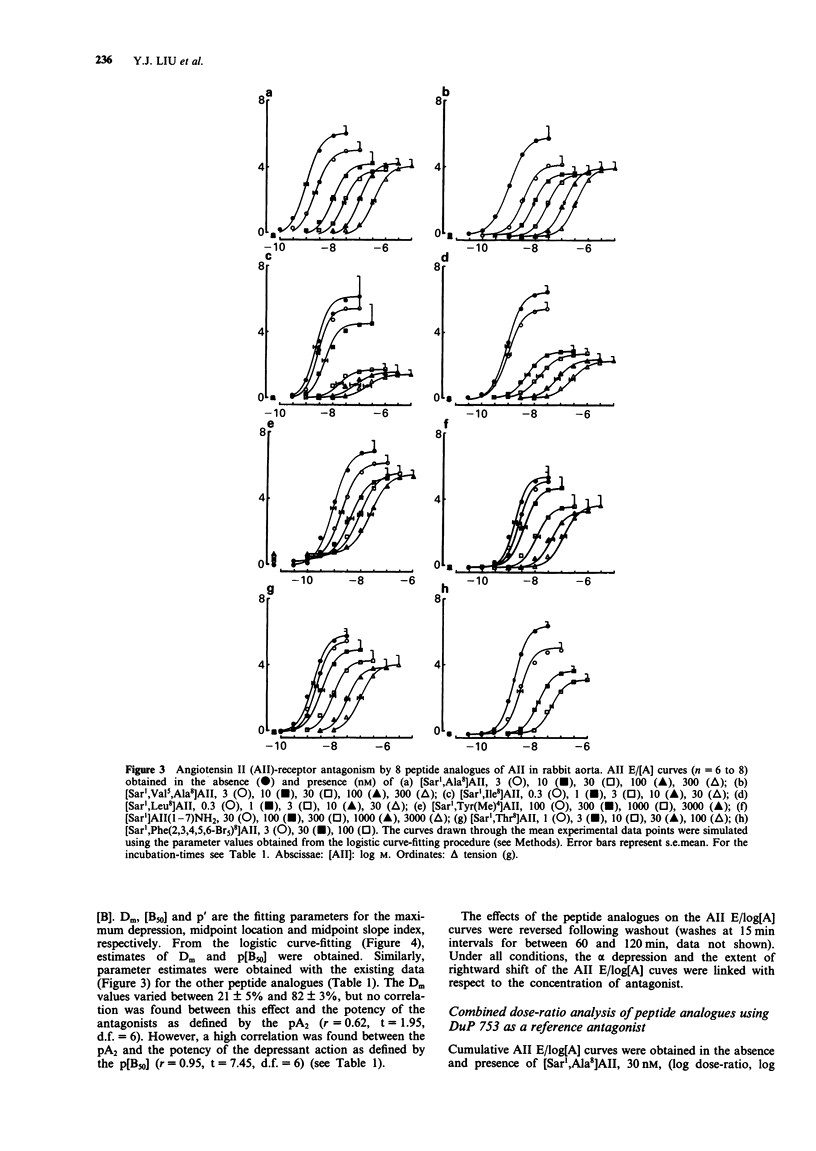
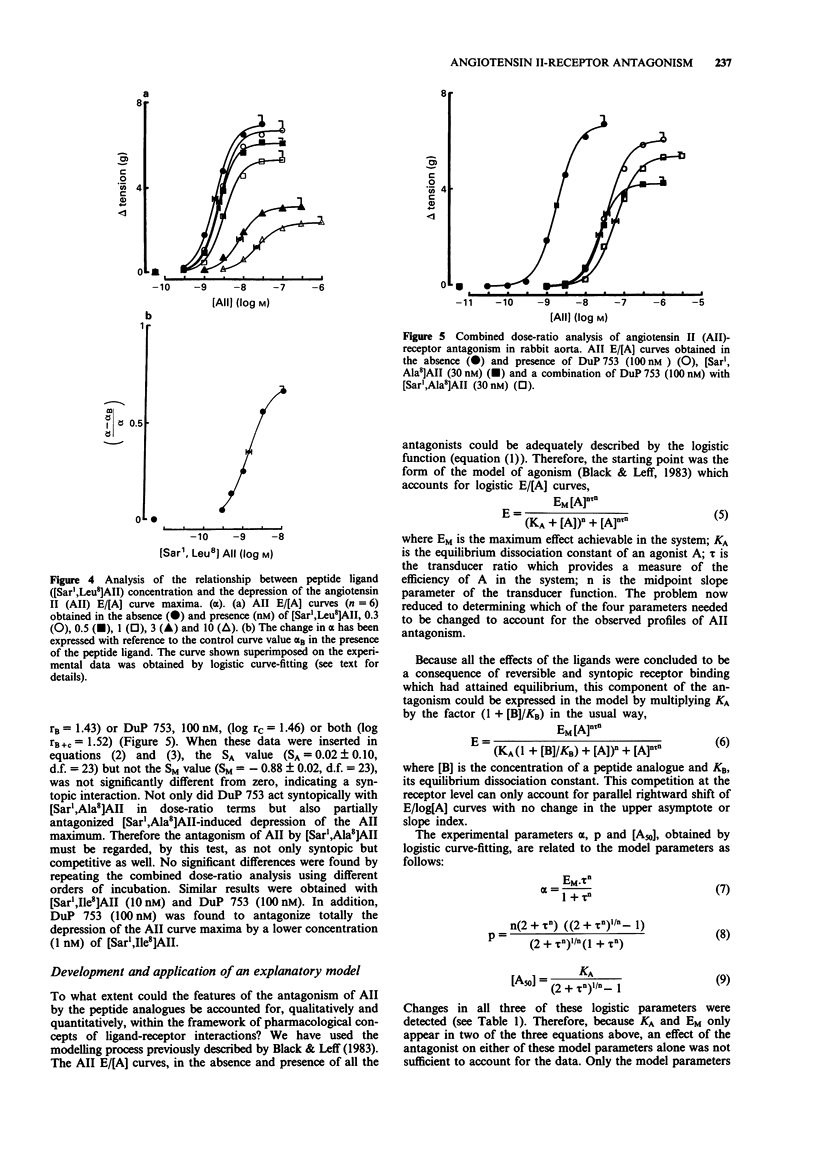
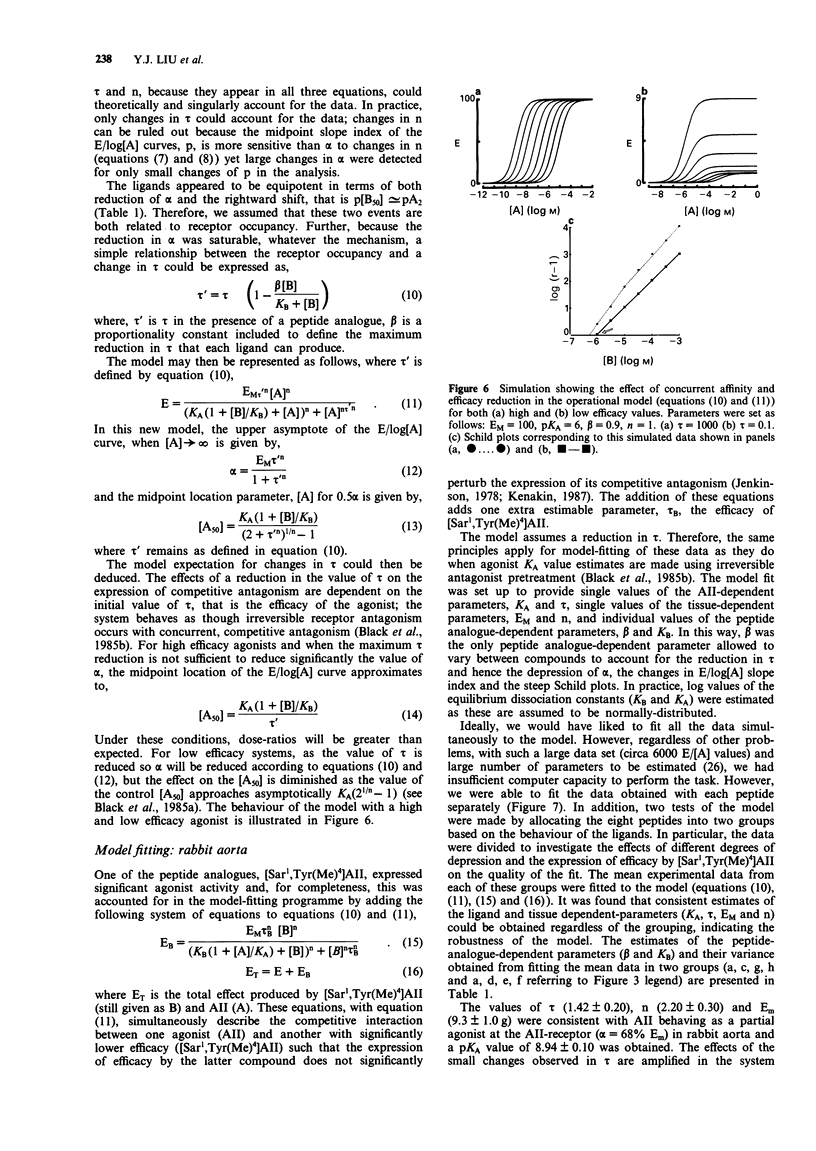
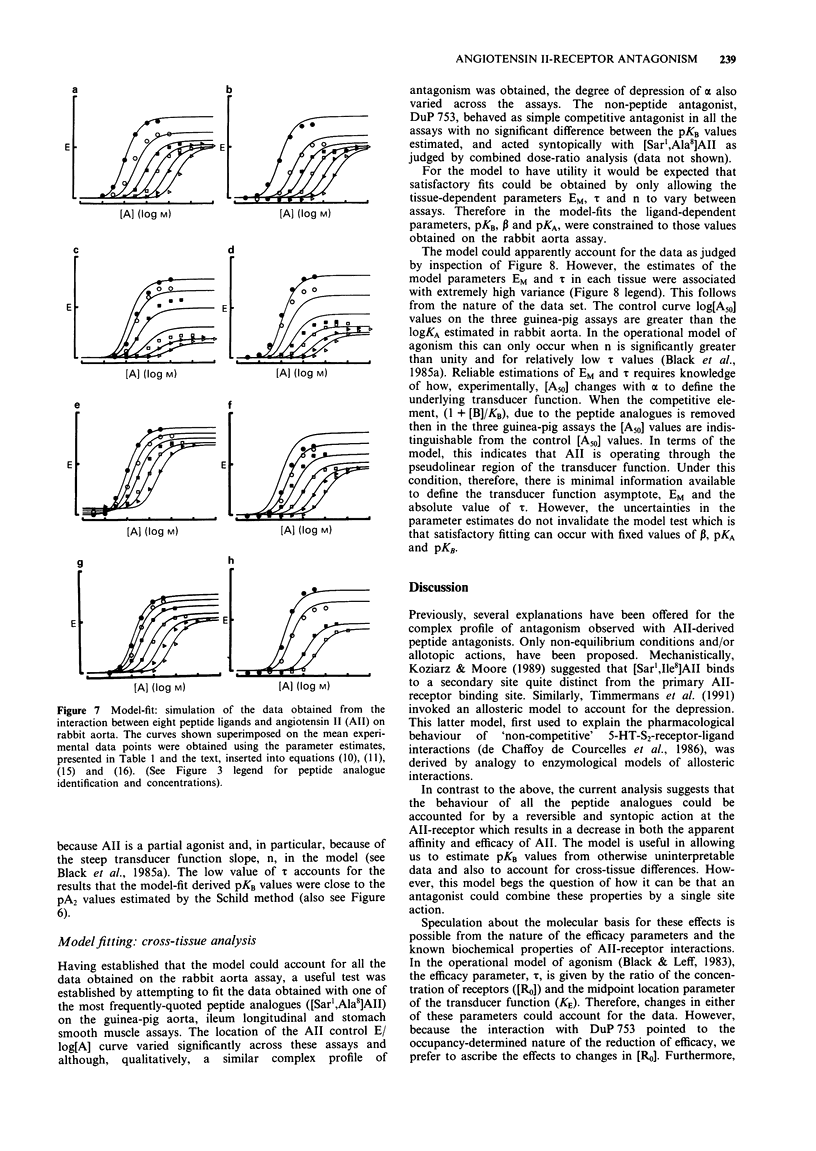
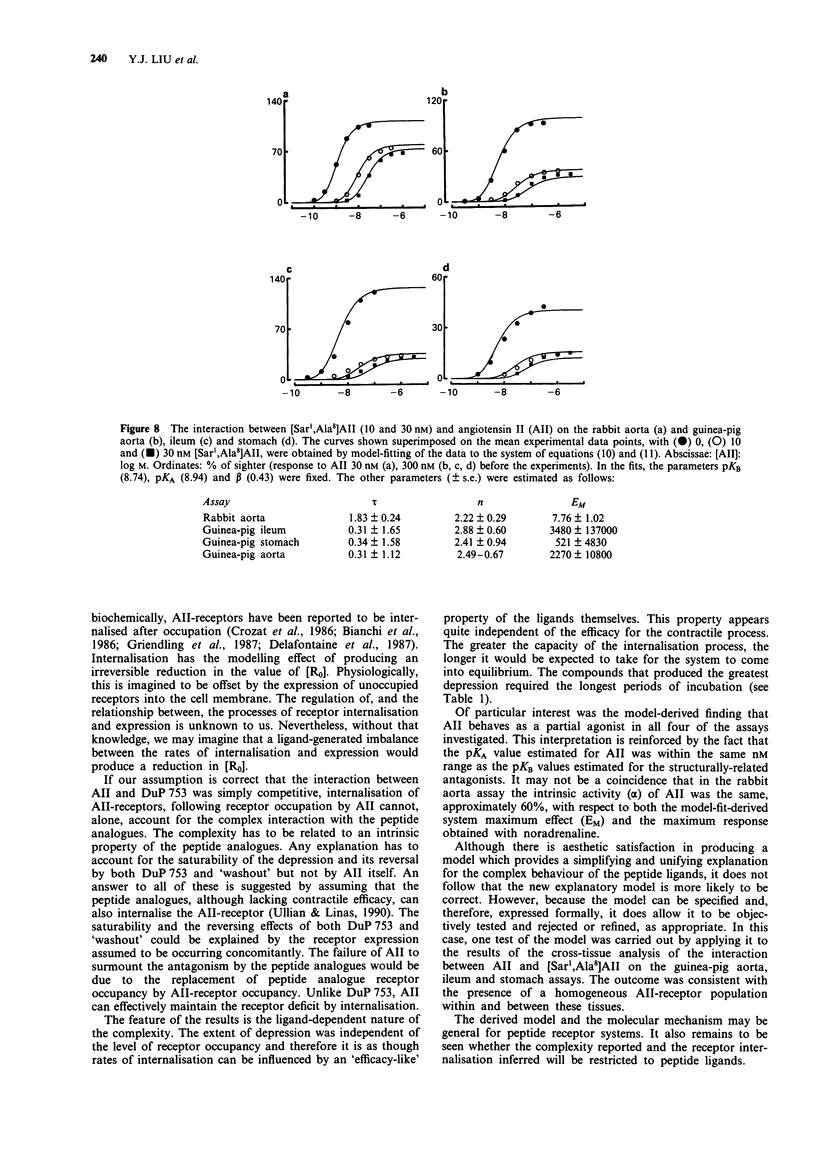
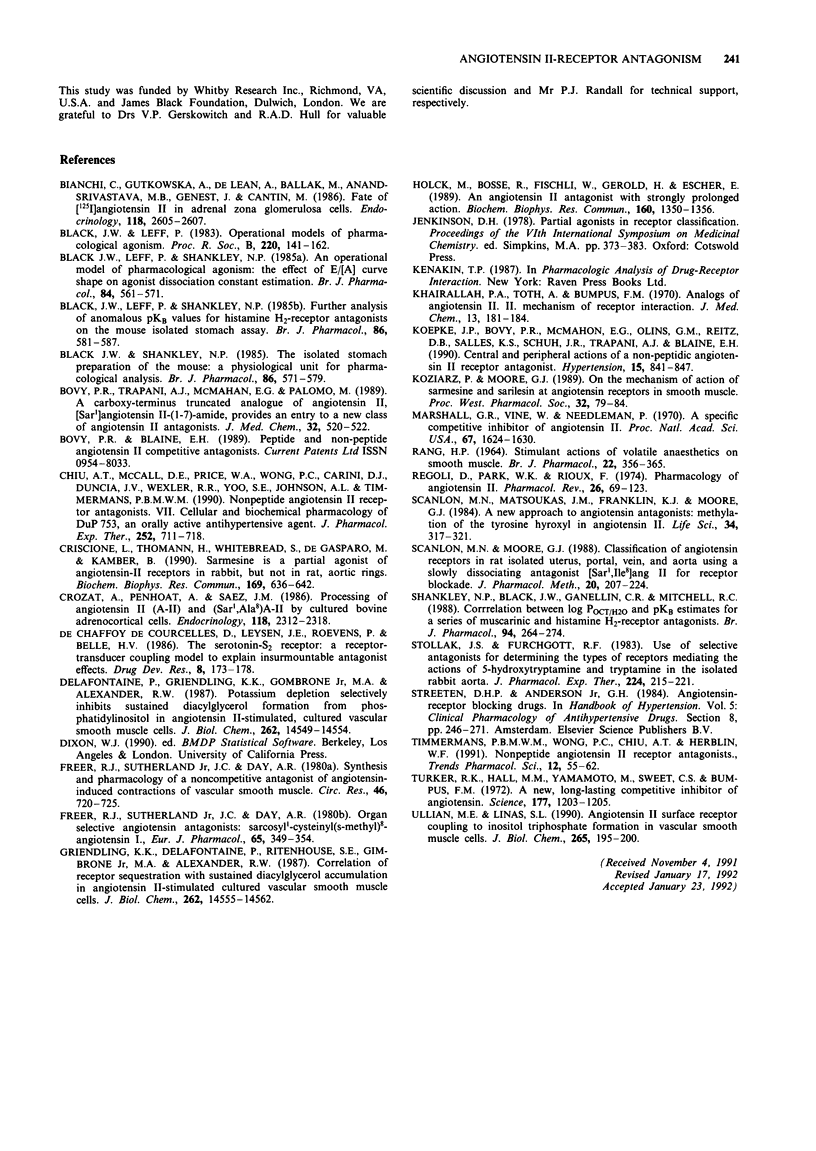
Selected References
These references are in PubMed. This may not be the complete list of references from this article.
- Bianchi C., Gutkowska J., De Léan A., Ballak M., Anand-Srivastava M. B., Genest J., Cantin M. Fate of [125I]angiotensin II in adrenal zona glomerulosa cells. Endocrinology. 1986 Jun;118(6):2605–2607. doi: 10.1210/endo-118-6-2605. [DOI] [PubMed] [Google Scholar]
- Black J. W., Leff P. Operational models of pharmacological agonism. Proc R Soc Lond B Biol Sci. 1983 Dec 22;220(1219):141–162. doi: 10.1098/rspb.1983.0093. [DOI] [PubMed] [Google Scholar]
- Black J. W., Leff P., Shankley N. P. Further analysis of anomalous pKB values for histamine H2-receptor antagonists on the mouse isolated stomach assay. Br J Pharmacol. 1985 Nov;86(3):581–587. doi: 10.1111/j.1476-5381.1985.tb08934.x. [DOI] [PMC free article] [PubMed] [Google Scholar]
- Black J. W., Leff P., Shankley N. P., Wood J. An operational model of pharmacological agonism: the effect of E/[A] curve shape on agonist dissociation constant estimation. Br J Pharmacol. 1985 Feb;84(2):561–571. doi: 10.1111/j.1476-5381.1985.tb12941.x. [DOI] [PMC free article] [PubMed] [Google Scholar]
- Black J. W., Shankley N. P. The isolated stomach preparation of the mouse: a physiological unit for pharmacological analysis. Br J Pharmacol. 1985 Nov;86(3):571–579. doi: 10.1111/j.1476-5381.1985.tb08933.x. [DOI] [PMC free article] [PubMed] [Google Scholar]
- Bovy P. R., Trapani A. J., McMahon E. G., Palomo M. A carboxy-terminus truncated analogue of angiotensin II, [Sar1]angiotensin II-(1-7)-amide, provides an entry to a new class of angiotensin II antagonists. J Med Chem. 1989 Mar;32(3):520–522. doi: 10.1021/jm00123a002. [DOI] [PubMed] [Google Scholar]
- Chiu A. T., McCall D. E., Price W. A., Wong P. C., Carini D. J., Duncia J. V., Wexler R. R., Yoo S. E., Johnson A. L., Timmermans P. B. Nonpeptide angiotensin II receptor antagonists. VII. Cellular and biochemical pharmacology of DuP 753, an orally active antihypertensive agent. J Pharmacol Exp Ther. 1990 Feb;252(2):711–718. [PubMed] [Google Scholar]
- Criscione L., Thomann H., Whitebread S., de Gasparo M., Kamber B. Sarmesin is a partial agonist of angiotensin-II receptors in rabbit, but not in rat, aortic rings. Biochem Biophys Res Commun. 1990 Jun 15;169(2):636–642. doi: 10.1016/0006-291x(90)90378-z. [DOI] [PubMed] [Google Scholar]
- Crozat A., Penhoat A., Saez J. M. Processing of angiotensin II (A-II) and (Sar1,Ala8)A-II by cultured bovine adrenocortical cells. Endocrinology. 1986 Jun;118(6):2312–2318. doi: 10.1210/endo-118-6-2312. [DOI] [PubMed] [Google Scholar]
- Delafontaine P., Griendling K. K., Gimbrone M. A., Jr, Alexander R. W. Potassium depletion selectively inhibits sustained diacylglycerol formation from phosphatidylinositol in angiotensin II-stimulated, cultured vascular smooth muscle cells. J Biol Chem. 1987 Oct 25;262(30):14549–14554. [PubMed] [Google Scholar]
- Freer R. J., Sutherland J. C., Jr, Day A. R. Organ selective angiotensin antagonists: sarcosyl1-cysteinyl(S-methyl)8-angiotensin I. Eur J Pharmacol. 1980 Aug 8;65(4):349–354. doi: 10.1016/0014-2999(80)90338-6. [DOI] [PubMed] [Google Scholar]
- Freer R. J., Sutherland J. C., Jr, Day A. R. Synthesis and pharmacology of a noncompetitive antagonist of angiotensin-induced contractions of vascular smooth muscle. [Sarcosyl]1-[cysteinyl (s-methyl)]8-angiotensin II. Circ Res. 1980 May;46(5):720–725. doi: 10.1161/01.res.46.5.720. [DOI] [PubMed] [Google Scholar]
- Griendling K. K., Delafontaine P., Rittenhouse S. E., Gimbrone M. A., Jr, Alexander R. W. Correlation of receptor sequestration with sustained diacylglycerol accumulation in angiotensin II-stimulated cultured vascular smooth muscle cells. J Biol Chem. 1987 Oct 25;262(30):14555–14562. [PubMed] [Google Scholar]
- Holck M., Bossé R., Fischli W., Gerold H., Escher E. An angiotensin II antagonist with strongly prolonged action. Biochem Biophys Res Commun. 1989 May 15;160(3):1350–1356. doi: 10.1016/s0006-291x(89)80152-4. [DOI] [PubMed] [Google Scholar]
- Khairallah P. A., Toth A., Bumpus F. M. Analogs of angiotensin II. II. Mechanism of receptor interaction. J Med Chem. 1970 Mar;13(2):181–184. doi: 10.1021/jm00296a003. [DOI] [PubMed] [Google Scholar]
- Koepke J. P., Bovy P. R., McMahon E. G., Olins G. M., Reitz D. B., Salles K. S., Schuh J. R., Trapani A. J., Blaine E. H. Central and peripheral actions of a nonpeptidic angiotensin II receptor antagonist. Hypertension. 1990 Jun;15(6 Pt 2):841–847. doi: 10.1161/01.hyp.15.6.841. [DOI] [PubMed] [Google Scholar]
- Koziarz P., Moore G. J. On the mechanism of action of sarmesin and sarilesin at angiotensin receptors in smooth muscle. Proc West Pharmacol Soc. 1989;32:79–84. [PubMed] [Google Scholar]
- Marshall G. R., Vine W., Needlemann P. A specific competitive inhibitor of angiotensin II. Proc Natl Acad Sci U S A. 1970 Nov;67(3):1624–1630. doi: 10.1073/pnas.67.3.1624. [DOI] [PMC free article] [PubMed] [Google Scholar]
- RANG H. P. STIMULANT ACTIONS OF VOLATILE ANAESTHETICS ON SMOOTH MUSCLE. Br J Pharmacol Chemother. 1964 Apr;22:356–365. doi: 10.1111/j.1476-5381.1964.tb02040.x. [DOI] [PMC free article] [PubMed] [Google Scholar]
- Regoli D., Park W. K., Rioux F. Pharmacology of angiotensin. Pharmacol Rev. 1974 Jun;26(2):69–123. [PubMed] [Google Scholar]
- Scanlon M. N., Matsoukas J. M., Franklin K. J., Moore G. J. A new approach to angiotensin antagonists: methylation of the tyrosine hydroxyl in angiotensin II. Life Sci. 1984 Jan 23;34(4):317–321. doi: 10.1016/0024-3205(84)90618-0. [DOI] [PubMed] [Google Scholar]
- Scanlon M. N., Moore G. J. Classification of angiotensin receptors in rat isolated uterus, portal vein, and aorta using a slowly dissociating antagonist [Sar1,Ile8]ANG II for receptor blockade. J Pharmacol Methods. 1988 Nov;20(3):207–224. doi: 10.1016/0160-5402(88)90064-2. [DOI] [PubMed] [Google Scholar]
- Shankley N. P., Black J. W., Ganellin C. R., Mitchell R. C. Correlation between log POCT/H2O and pKB estimates for a series of muscarinic and histamine H2-receptor antagonists. Br J Pharmacol. 1988 May;94(1):264–274. doi: 10.1111/j.1476-5381.1988.tb11523.x. [DOI] [PMC free article] [PubMed] [Google Scholar]
- Stollak J. S., Furchgott R. F. Use of selective antagonists for determining the types of receptors mediating the actions of 5-hydroxytryptamine and tryptamine in the isolated rabbit aorta. J Pharmacol Exp Ther. 1983 Jan;224(1):215–221. [PubMed] [Google Scholar]
- Timmermans P. B., Wong P. C., Chiu A. T., Herblin W. F. Nonpeptide angiotensin II receptor antagonists. Trends Pharmacol Sci. 1991 Feb;12(2):55–62. doi: 10.1016/0165-6147(91)90498-h. [DOI] [PubMed] [Google Scholar]
- Türker R. K., Hall M. M., Yamamoto M., Sweet C. S., Bumpus F. M. A new, long-lasting competitive inhibitor of angiotensin. Science. 1972 Sep 29;177(4055):1203–1205. doi: 10.1126/science.177.4055.1203. [DOI] [PubMed] [Google Scholar]
- Ullian M. E., Linas S. L. Angiotensin II surface receptor coupling to inositol trisphosphate formation in vascular smooth muscle cells. J Biol Chem. 1990 Jan 5;265(1):195–200. [PubMed] [Google Scholar]


